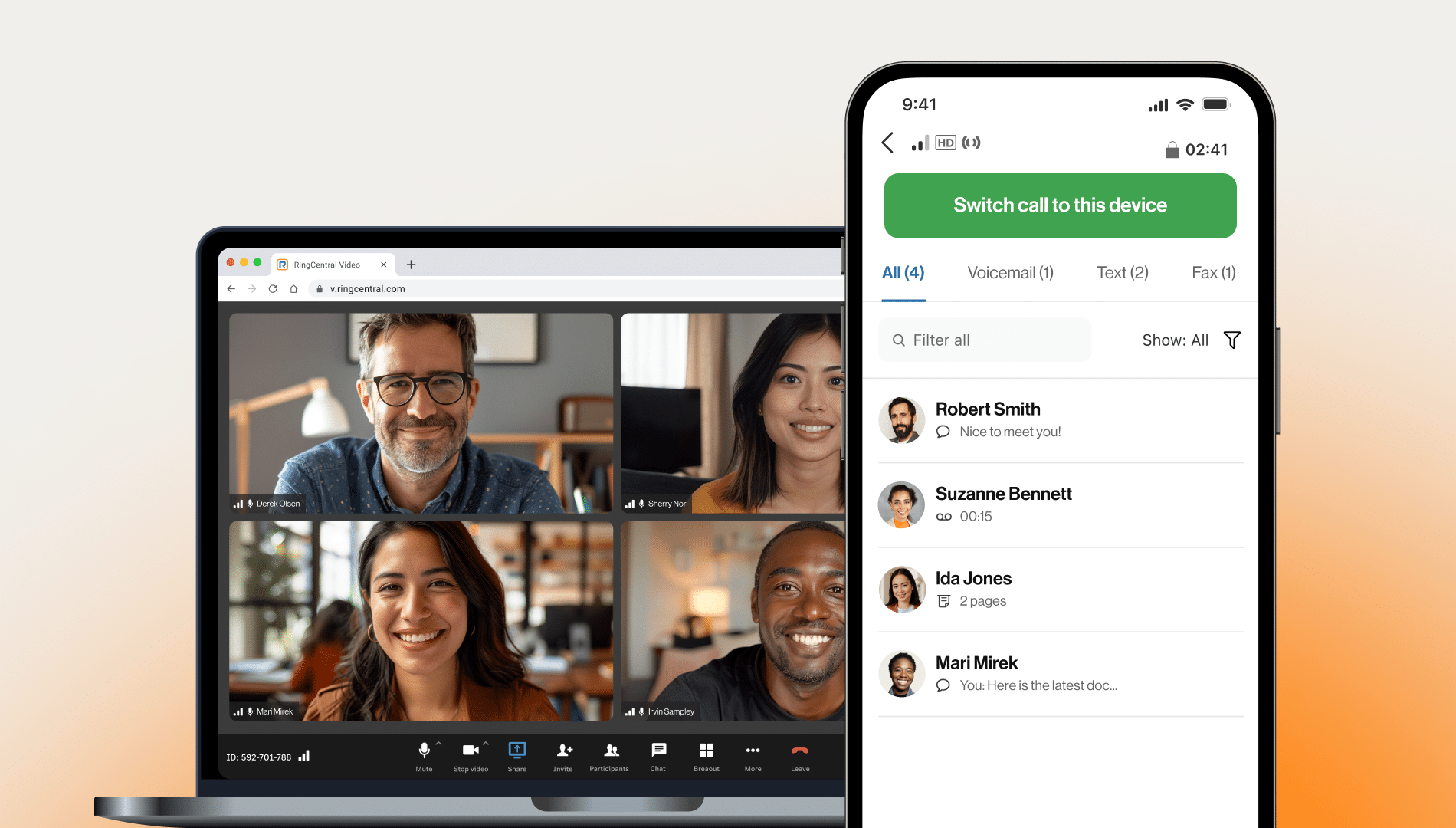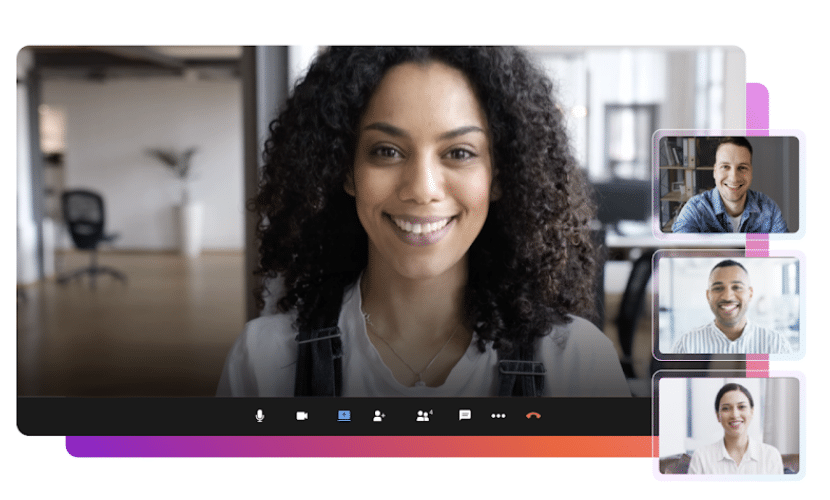Looking for a Zoom alternative for free video conferencing and virtual meetings? You’re not alone.
Video calls and online meetings are a staple of modern business. With the popularity of remote and hybrid working arrangements showing no sign of abating, that’s not likely to change.
Businesses, then, need the right tools to ensure they can video conference efficiently, safely, and productively. And that’s why many are searching for Zoom alternatives to meet their needs.
We’re going to suggest 8 top alternatives to Zoom for you to choose from. You can skip ahead if you like:
Before we get to our Zoom competitors, though, let’s take a minute to take a closer look at Zoom itself and why it may not be everything your business needs.
What is Zoom & why might you need a Zoom alternative?
Zoom—or Zoom Workplace—is a video calling and conferencing platform. Apps like Zoom have been around for a while, but gained widespread fame during the COVID-19 pandemic. They were where workers and businesses turned when they had no choice but to work remotely.
However, platforms like Zoom weren’t originally designed for high volume, professional use. For that reason, while Zoom Workplace has lots of great features, it might not be robust enough for your business operations.
For example, the Zoom Workplace basic plan—which is their free to use option—only allows meetings for 40 minutes, which might be enough for standups and recurring one-on-ones, but not for longer meetings like town halls or quarterly planning sessions. Because of Zoom’s mainstream popularity with consumers, it has also attracted more unwanted attention from hackers and bad actors (with past issues with security and Zoombombing).
Plus, the free version of Zoom Workplace doesn’t provide full HD video1 (unlike competitors such as RingCentral Video), with that being limited to the Business and Enterprise Plans. That can cause issues with screen freezing and time-lag. In a meeting capped at 40 minutes, that sort of thing can waste a lot of valuable time.
Luckily, if you are looking for an alternative to Zoom, there are lots of other free video conferencing options at your disposal. There’s bound to be one that suits your needs.
🤔 What are the top four affordable Zoom alternatives? Check out this comparison chart.
What do competitors need to be a feasible Zoom alternative?
There are many video chat apps you can choose from, but which of those options contains the attributes needed to be considered a genuine Zoom alternative?
Here are some of the attributes competitor apps need:
- Seamless, uninterrupted hi-def audio and video. (A basic must for any Zoom alternative.)
- Easy to use (simple to arrange and participate in meetings and add incoming guests, ideally with “one-click” interaction).
- Secure (offering solid encryption to prevent unwanted guests).
- Simple video recording capabilities.
- Collaborative tools (not just standard features like screen-sharing and chat functions—also whiteboarding and other similar options)
8 Top Zoom alternatives for video calling and conferencing
To save you from digging through the information yourself, we’ve pulled together a list of our top eight alternatives to Zoom and their pros and cons:
| Zoom alternatives | Easy to use | Secure | Good integration | Good customer service | Budget friendly | Large group calls |
| RingCentral Video |
✓ |
✓ |
✓ |
✓ |
✓ |
✓ |
| Webex Free by Cisco |
✓ |
✓ |
✖ |
✓ |
✖ |
✓ |
| Microsoft Teams |
✖ |
✓ |
✓ |
✖ |
✖ |
✓ |
| GoToMeeting |
✓ |
✖ |
✓ |
✖ |
✖ |
✖ |
| Google Meet |
✓ |
✖ |
✖ |
✖ |
✓ |
✖ |
| Jitsi Meet |
✓ |
✖ |
✓ |
✖ |
✓ |
✓ |
| Meet Now via Skype |
✓ |
✖ |
✖ |
✓ |
✓ |
✖ |
| Chanty |
✓ |
✓ |
✖ |
✖ |
✓ |
✖ |
1. RingCentral Video – A top Zoom alternative that’s free to use (with advanced features)
Free alternatives to Zoom aren’t all that common—certainly not ones that genuinely have everything your business will need day to day. RingCentral’s free Zoom alternative, RingCentral Video Pro, however, bucks the trend. It really does tick all the boxes, and should cover all your bases.
The free video conferencing solution comes with high-definition quality video and carrier-grade security as standard, and is particularly suited to distributed and remote teams. It integrates the best of Slack, Google’s G Suite and Microsoft 365.
In terms of user-friendliness, RingCentral Video scores high. It’s incredibly easy to set up an account (all you need is an email and a password), and when you invite someone onto a call, they need neither install any apps or create their own account. As with Zoom, they can call in via a web browser or phone. If they join via a browser, they only need to provide their name to gain access. The name they offer will then be displayed on their video window for the benefit of other call participants.
Best of all, RingCentral Video works seamlessly with the other RingCentral solutions, meaning you can easily and efficiently combine video meetings with internal team communications, customer interactions, and more.

Key features
RingCentral Video Pro (100% free!) allows unlimited 50-minute video conferences with up to 100 participants in HD quality. You can also record your video meetings, which you can then store for seven days. The app also includes unlimited audio conferencing and mobile apps for iOS and Android:

With an upgrade to RingCentral Video Pro+ ($10 per user per month), you can host meetings of up to 24 hours in duration and with up to 200 participants. You can also store up to 100 hours of recorded conferences, and those recordings are available to download or share for a full year.
Within the RingCentral Video app, you can enjoy:
- HD-quality voice, video, and screen sharing
- Text chat in video conference: Drop a private or group message during virtual meetings
- Task management: Create and assign tasks with deadlines to teammates to better organize your workflows
- Easy-to-use app (mobile and desktop-ready) which allows you to join meetings from anywhere
- Team messaging: One-to-one and groups of all sizes
- Email and calendar integrations: Add meeting links with one click
- No-download, one-click video conferencing: Guests can join meetings via any browser
- External guest access to the team messaging feature
- File sharing, storage, and annotation

2. Webex Free by Cisco

Webex Free is another of the best Zoom alternatives for businesses looking to maximize their budget. With it, you can host meetings with up to 100 participants per meeting for a maximum of 40 minutes.2
You can share screens, use a whiteboard, record meetings, and carry out live polls via Slido. You can join Webex Free via phone (and allow attendees to join by dialling in) as long as you buy the required add-on.
The cheapest paid plan, Webex Meet (which costs $12 per license per month, under annual billing), increases the meeting length to 24 hours, and the participant limit to 200. The Webex Enterprise plan enables up to 100,000 participants and unlimited hosts.
Key features
It’s good for collaboration, with the free tier offering screen sharing plus an interactive whiteboard and messaging feature. However, you’ll still need to upgrade for recording capability and storage, dial-in access, and international call-ins.
Webex Free has mobile apps for both Android and Apple smartphones and integrates with Google Drive, Microsoft 365, and Salesforce, among other tools.
All paid plans include transcriptions, file transfer, chat, “raise hand,” and polling features. Like RingCentral Video, Webex has robust security features for a free plan, offering firewall compatibility, SSO, and secure scheduling options. Webex Free also cleverly harnesses rudimentary AI-based features. They allow you to share highlights of detailed conversations, catch up on missed conversations, or, when dealing with customers, provide snap advice regarding live queries.
Unlike RingCentral Video, however, live customer support is not available with Webex Free. And Webex Free is not user-friendly. Unless you’re already very familiar with conferencing tools, it’s probably not the best option, as it takes a while to become properly acclimated.
3. Microsoft Teams (Home Plan)

While Microsoft Teams does offer a free version, that is marketed as a “Home Plan” rather than a business-focused tool.3 There are three paid Business Plans.
Regarded as a good way to replicate the in-office experience, this shared workspace combines chat, meetings, file sharing, and business apps. It’s best suited to a Microsoft-centric environment.
No account is required to join a meeting, and there is a browser-based option, but it’s only fully functional on Edge or Chrome.
All paid plans offer video calls with up to 300 members—but you can only view nine participants simultaneously, which means it’s a very limited Zoom alternative.
Key features
Microsoft Teams’ free plan comes with standard video conference tools like screen sharing and a chat function, plus customizable backgrounds and web versions of Microsoft products. Other useful functions include participant lists, live captions, and shareable recordings—however, meeting recordings and transcriptions aren’t available, even on the cheapest paid plan. The platform does also feature some useful collaboration tools, including the ability to coauthor content and unlimited one-on-one meetings. Users also benefit from 5GB of free storage. Audio conferencing is available, albeit as an add-on to the paid tiers, meaning guests can join meetings from a phone (something that comes standard with RingCentral Video). Project management tools can be added, too.
On the downside, the free version has limited functionality, and doesn’t feature administration tools such as analytics, access to on-premise servers, or 24/7 phone or web support. The paid plans (starting at $12.50 a month per user, though with mandatory annual commitment) do offer some security, management, and compliance tools. However, the higher tiers are only available with Microsoft 365 Business Premium or Microsoft 365 Enterprise E3. And it’s worth pointing out that Teams is far from user-friendly compared to RingCentral Video, and is relatively hampered by complex functionality.
4. GoToMeeting

GoToMeeting’s video conferencing app has been around for a while and offers scalable solutions, though in truth it’s geared toward high numbers of participants.
The cheapest Professional Plan (starting at $12 a month, though under annual terms; month-by-month pricing starts at $14) allows for 150 attendees, with unlimited meeting time. The Business and Enterprise Plans can accommodate up to 250 participants.4
Key features
GoToMeeting is a relatively simple Zoom alternative to set up and is pretty handy for collaboration, with co-hosting capabilities and an interactive whiteboard as well as screen sharing. Compared to some other conferencing platforms, GoToMeeting is user-friendly, with simple controls. Plus, meeting attendees don’t need to download desktop or mobile software in order to share screens, and the platform supports all Chrome web browsers.
The lowest tier also offers a dial-in function, while the two higher-priced plans give you unlimited cloud recording plus transcripts, drawing tools, and a Smart Assistant. GoToMeeting provides optional toll-free numbers for over 50 countries. If you include this feature, you’ll only pay for what you use. You’ll also get custom email invitations, integrated scheduling, and one-click meetings.
Other useful tools include live in-meeting notes that can be shared afterward, and “Slide to PDF” for faster sharing of presentations. There’s also a PIN-based entry system, as well as polling and “raise a hand” features.
You can use GoToMeeting on Mac, PC, Android, and iOS devices, and there are plug-ins for Microsoft 365 and Google Calendar.
However, the trade-off is that GoToMeeting falters a little on audio quality and uses a higher bandwidth than other similar platforms. There’s also no free GoToMeeting option. With superior free options on the market, it’s hard to justify forking out for this one.
There’s also no webinar functionality unless you choose to add sister product GoToWebinar. But if you need a business VoIP solution, then you’d need to add a GoToConnect plan—or just use RingEX, which comes with business calling, messaging, and all RingCentral Video’s features in one integrated solution.
5. Google Meet

Google Meet (formerly Hangouts Meet) is one of the best-known video meeting platforms aimed at business users.
It’s part of Google Workplace (formerly G Suite), whose users can tap straight into Meet. Guests can join directly from a Calendar event, email invite, or Gmail. Other familiar but welcome features include a selection of background images and a ‘blur’ option for privacy, shared-screen presenting, a ‘raised hand’ option during conversations and a chat feature. You can also use a variety of emojis, should you need them.
Key features
Google Meet comes as part of the broader Google Workspace Plan. The cheapest Business Starter Plan ($6 per month if part of an annual agreement) includes Meet video conferences for up to 100 users and a maximum length of 24 hours. The top Enterprise tier (for further details on price you’ll need to speak to a representative as at this rate all arrangements are bespoke) allows 1,000 attendees. Plus, you can save meeting recordings to Google Drive.5
Other features include the familiar Google interface and security features similar to those offered by RingCentral (which itself integrates seamlessly with Google Workspace).
A key issue with this Zoom alternative, though, is that all users need a Google account6 in order to host or even join a meeting. This could present a barrier to seamless use, especially if you expect to conference with stakeholders and clients who use other platforms for their email and calendars. There’s another problem you might want to bear in mind: since Google is phasing out its native whiteboards, you’ll soon need to find a third-party option compatible with the platform.
6. Jitsi Meet

Jitsi Meet is a bit unique compared to other video conferencing apps. It’s completely free to use, with no need to create an account—which will certainly appeal to very small businesses and startups looking for Zoom alternatives.
For everyone else, however, you may crave more advanced features than those on offer. And a major sticking point is that all meetings have a maximum of 50 participants, with no option to upgrade to a paid tier with extra capacity or features.7
Key features
Jitsi Meet is well known for its security, with a range of privacy features including control over which devices it can access. Using its own end-to-end encryption, Jitsi Meet protects users’ privacy with password-protected meetings.
It’s also a user-friendly platform: after entering the website, all you need to do is name your meeting and follow a prompt to invite other attendees.
The software offers basics like screen sharing and presentation live streaming, as well as an integrated chat app for groups and individuals within video meetings.
You can also view a list of recent past meetings, connect your calendar to schedule upcoming ones, and create a user profile—while other handy functions include “pass presenter” and file editing through Etherpad.
Because it’s open-source software, users can completely customize their own platform and add various advanced features. However, those who don’t have development experience might prefer a platform with access to extras as part of a paid plan. It’s also worth pointing out that Jitsi Meet currently offers no personal or business support. Should you have any questions, you’ll need to rely on community message boards to help you solve any technical issues. Since some of the self-hosted solutions will probably require some technical knowledge, this is a potential drawback.
Jitsi Meet is compatible with Android and iPhone mobile apps. There’s also WebRTC compatibility, a Google Chrome extension, and integrations with Microsoft 365 and Slack.
7. Meet Now via Skype

Meet Now is a Skype feature that was added to improve its video conferencing experience.
It’s free to use for a maximum of 100 people in one meeting. Each video call can last up to 24 hours, although the meeting never technically expires.8
Key features
Meet Now is an app that’s similar to Zoom in that hosts can set up and share a free meeting. It’s integrated into Windows 10 and newer operating systems so the icon will appear in the taskbar for ease of use.
There’s no need for hosts or guests to install anything or even to create an account. Not even the host needs to have Skype installed, as the process can be started from its website.
If an invitee has Skype installed, it will open the app directly to the call—otherwise it will open the web client in Chrome or Edge. (Only those browsers are officially supported so far.9 That means platforms that are compatible with all major browsers, like RingCentral, will be generally more convenient for users.)
Meet Now gives you screen sharing, a chat function, and emoji reactions, and meetings can be recorded and stored for up to 30 days.
One particularly interesting Meet Now option is its ‘Live subtitles’ feature. This allows users to see what other participants say as live on-screen text. You can use this for both individual and group calls. The live subtitles are also collected as a resource in a side panel which you can then refer to after the call. The feature supports eleven languages: Chinese, English (US and UK), French, German, Italian, Japanese, Portuguese, Russian and Spanish. For businesses with a broad group of global clients, this is obviously a potentially invaluable tool.
It’s not possible for users to customize backgrounds, but you can blur them if you need to (useful if you’re working in a place where people are walking by!)
Because there’s no paid tier, you won’t be able to upgrade to extra features—which significantly weakens Meet Now’s credentials as a Zoom alternative—although there’s a payment option if you need to make international calls.
8. Chanty

Chanty is team communication and collaboration software that was launched in 2017. As a basic Zoom alternative, its free plan includes one-on-one audio meetings and voice messages for teams of up to five members.
For one-on-one video calls and group audio calls or group video calls with up to 25 participants, you’ll need the Business plan, which starts at $3 per user, per month.10
Key features
It offers a simple and intuitive user experience. With the free version, you can have up to five team members and use public and private conversations to communicate and collaborate on projects. Plus it’s fairly easy to navigate your way around the pages and menus and use the functions on offer. It’s straightforward to toggle between screens, record messages, make calls and search through the message history to find whatever you need.
The paid plan, meanwhile, introduces unlimited group audio and video calls to bring it more in line with other video conference apps. It also offers unlimited integrations with third-party apps, including Trello, Asana, Zapier, Google Drive, Dropbox, Onedrive, Github, Gitlab, Giphy and more.
As you might expect, Chanty suffers some downsides. There’s no calendar view to allow you to visualize tasks, so you have to sift through due dates in tasks so you don’t miss completion dates. The conversations tab can become cluttered when multiple users are involved. Plus, you can mute chats but not one-on-one conversations.
Chanty also suffers from comparatively poor integration of other platforms to increase functionality.
Other Zoom alternatives
As well as the options listed above, there are many more Zoom alternatives. Let’s call them “the Zoom alternative also-rans”. That said, they may contain one or two useful features.
- AnyMeeting
- FreeConference
- Whereby
- Nextcloud Talk
- RemotePC Meeting
- U Meeting
How we tested the alternatives
To find the most feasible Zoom alternatives, we first gathered the opinions of former Zoom users who now use other platforms. We added those opinions to a list of the most popular options on the market. We then tested each platform for user-friendliness and range of features. Naturally, we also took the cost factor into account (when applicable) when we measured the value of each option before providing our final assessment.
Which is the best alternative to Zoom for business video conferencing?
When choosing a Zoom alternative, take the time to do some research and decide which software is most suited to your needs. One of the most common pitfalls teams encounter is that they pay attention only to the attractive pricing, but don’t look at all the features (which ones are included, and which are excluded?) and read the customer reviews.
If you’re considering free video software, why not check out RingCentral Video Pro? We may be a bit biased, but in terms of overall value and robustness of the technology, it truly is one of the best Zoom alternatives.
Unlike most video meeting apps, RingCentral Video Pro’s powerful video conferencing solution integrates seamlessly with a huge number of other communications solutions, and offers features for free that other companies charge for. And when it’s time to scale up, RingCentral Video Pro+ has the larger capacity and administrative tools you’ll need for a smooth transition. Try it for free now!
1support.zoom.com/hc/en/article?id=zm_kb&sysparm_article=KB0066166&_device_id=71777e25-b8d1-48ef-8048-9c2523ef5fdf&_ics=1718095704530&irclickid=~813WSPRHEyspqlrmlmszpghe929~573V1SOJKABqlhb30VUJHyvl&_gl=1*193ubbr*_ga*MTExMTIxNDQ1Ni4xNzE4MDk1NzA0&_ga=2.32036220.333587027.1718095704-1111214456.1718095704
2pricing.webex.com/ca/en/
3microsoft.com/en-us/microsoft-teams/compare-microsoft-teams-home-options
4goto.com/pricing/meeting
5workspace.google.com/pricing.html
6workspace.google.com/intl/en/resources/video-conferencing/
7community.jitsi.org/t/maximum-number-of-participants-on-a-meeting-on-meet-jit-si-server/22273
8skype.com/en/free-conference-call/
9support.microsoft.com/en-us/skype/what-is-meet-now-and-how-do-i-use-it-in-skype-9b721076-fcdf-437b-89a4-d2c8c959ac6b
10chanty.com/pricing/
FAQs
Why should I use an alternative to Zoom?
Zoom became a household name after its popularity exploded a few years ago, but it’s not the only option out there. While it does a good job for basic video conferencing, there are other video apps that come with additional features you might find useful in your company’s day-to-day operations.
What kind of features should I look for in a Zoom alternative?
This depends on what you want to use it for. First, think about how many people you want to be able to participate in meetings. Some applications put much lower limits than others on the total number of participants. Then consider what else you need the software to do. For instance, do you need HD video as standard? Webinar functionality? Check that your choice of Zoom alternative will be a good fit for your organization.
Is RingCentral free?
Yes! RingCentral offers a completely free version of its video conferencing tool. You can download the RingCentral Video app on iOS and Android devices, and onto your laptop or computer. Although RingCentral offers several paid service tiers, you can still use many of its market-leading features via its free version.
Originally published Jun 07, 2024, updated Mar 13, 2025












